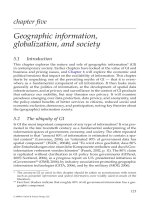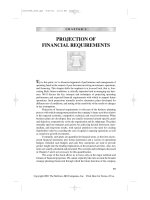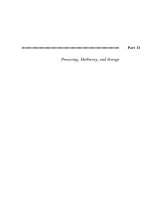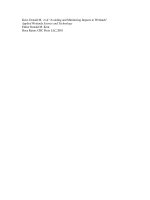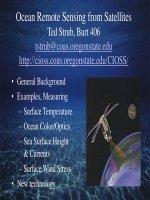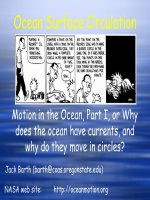PHYSICS 3 (ELECTRICITY AND MAGNETISM) - CHAPTER 5 pps
Bạn đang xem bản rút gọn của tài liệu. Xem và tải ngay bản đầy đủ của tài liệu tại đây (167.1 KB, 6 trang )
Electricity and Magnetism
53
Chapter 5
ELECTROMAGNETIC INDUCTION
5.1 Faraday’s Law of Induction
1)
In Fig. 5.1 an ammeter is connected in the circuit of a conducting loop. When the bar magnet is moved
closer to, or farther from, the loop, an electromotive force (emf) is induced in the loop. The ammeter
indicates currents in different directions depending on the relative motion of magnet and loop. Notice
that, when the magnet stops moving, the current returns to zero as indicated by the ammeter
Fig. 5.1 : Electromagnetic Induction
The magnetic flux
Φ
B
through an area A in a magnetic field
B
r
is defined as (Fig. 5.2)
Φ
B
=
∫
A.dB
r
r
[Wb] (5.1)
where the integration is taken over the area.
Fig. 5.2
Faraday’s Law of Induction : The induced electromotive force
e =
dt
d
B
Φ
−
(5.2)
2) Lenz’s Law
: An induced current has a direction such that the magnetic field due to the current opposes
the changes in the magnetic flux that induced the current. The induced emf has the same direction as the
induced current.
3) Electromotive force and the induced electric field
: An emf is induced by a changing magnetic flux
even if the loop through which the flux is changing is not a physical conductor. The induced emf is related
to the electric field E by
e =
∫
sdE
r
r
(5.3)
Electricity and Magnetism
54
where the integration is taken around the loop. It follows from (5.2) and (5.3) that
∫
sdE
r
r
=
dt
d
B
Φ
−
(5.4)
a changing magnetic field
B
r
induces an electric field
E
r
.
5.2 Inductors
1) Inductance
L =
i
N
B
Φ
[H] (5.5)
The inductance per unit length near the middle of a long solenoid of cross sectional area A and n turns per
unit length
L =
µ
o
n
2
A (5.6)
2) Self-induction
: If the current in a coil changes with time, an emf is induced in the coil
e = -
dt
di
L
(5.7)
The direction of e is found from the Lenz’s law : the direction of e acts to oppose the changes that
produces it.
5.3 Series RL circuit
1) Rise of current
(Fig. 5.3)
For t < 0, the switch K is at 2, i = 0A.
For t > 0, the switch K is at 1. Apply the loop rule
E =
dt
di
L
+ Ri
⇒
i =
E
R
(1-e
-t/τ
) (5.8)
where
τ
=
L
R
: inductive time constant.
Fig. 5.3 Fig. 5.4
Electricity and Magnetism
55
2) Decay of current
(Fig. 5.4)
For t < 0, the switch K is at 1, i =
E
R
.
For t > 0, the switch K is at 2. Apply the loop rule
0 =
dt
di
L
+ Ri
⇒
i =
E
R
e
-t/τ
(5.9)
where
τ
=
L
R
is the inductive time constant.
5.4 Magnetic Energy
Magnetic energy stored in an inductance
U
B
=
2
1
Li
2
(5.10)
Density of magnetic energy = magnetic energy / volume
u
B
=
o
2
2
B
µ
(5.11)
5.5 Mutual Induction
If coil 1 and 2 are near each other, a changing current in either coil can induce an emf in the other. This
mutual induction is described by
e
1
= -
dt
di
M
2
(5.12)
e
2
= -
dt
di
M
1
(5.13)
where M (measured in henries) is the mutual inductance for the coil arrangement.
Problems
5.1) A small loop of area 10cm
2
is placed inside a long solenoid that has 800 turns/cm and carries a
sinusoidally varying current I of amplitude 1A and angular frequency 300rad/s. The central axes of the
loop and the solenoid coincide. What is the amplitude of the electromotive force induced in the loop ?
5.2) In Fig. P5.1, the magnetic flux through the loop increases according to the relation
Φ
B
= 6t
2
+ 7t where
Φ
B
is in miliwebers and t is in seconds. What is the magnitude of the electromotive force induced in the loop
when t = 2s ? Is the direction of the current through R to the right or left ?
5.3) In Fig. P5.2, the triangle ABC is moving into a magnetic field B with velocity v. Find the electromotive
force e(t) induced in the loop. If the triangle has resistance R, find the magnitude and direction of the
current i in the triangle. AB = a, BC = b
Electricity and Magnetism
56
Fig. P5.1 Fig. P5.2
5.4) A rectangular coil of N turns and of length a, width b is rotated at frequency f in a uniform magnetic field
B indicated in Fig. P5.2. The coil is connected to co-rotating cylinders, against which metal brushes slide
to make contact. Find the electromotive force induced in the coil.
Fig. P5.2 Fig. P5.3
5.5) In Fig. P5.3, a rectangular loop of wire with length a = 2cm, width b = 0.8cm and resistance R = 0.4m
Ω
is
placed near an infinitely long wire carrying current i = 4A. At t = 0, r = r
o
= 0.1cm. The loop is then
moved away from the wire at constant speed v = 3mm/s. Find the magnitude of the magnetic flux through
the loop and the current induced in the loop.
5.6) Find the mutual inductance between the long wire and the rectangular loop (of N turns) in Fig. P5.3.
5.7) In Fig. P5.4, a long rectangular conducting loop, of width L, resistance R, and mass m, is hung in a
horizontal, uniform magnetic field B that exists only above line a-a. The loop is then dropped. During its
fall, it accelerates until it reaches a certain terminal speed v. Find an expression for v.
Fig. P5.4 Fig. P5.5
5.8) In Fig. P5.5, the current in the infinitely long wire is i =
α
t, the rectangle has resistance R. Find the value
and the direction of the induced current in the rectangle.
Electricity and Magnetism
57
5.9) A rectangular loop of n closely packed turns is positioned near a long straight wire as shown in Fig. P5.6.
What is the mutual inductance M for the loop-wire combination ?
Fig. P5.6
Homeworks 5
H5.1 In Fig. H5.1, the magnetic flux through the loop increases according to the relation
Φ
B
= at
2
+ bt where
Φ
B
is in miliwebers and t is in seconds. What is the magnitude of the electromotive force induced in the loop
when t = 1s ? What is the magnitude and the direction of the current through R [
Ω
] ?
Fig. H5.1 Fig. H5.2
n 1 2 3 4 5 6 7 8 9 10 11 12 13 14 15 16
a 4 5 6 7 8 9 10 11 12 13 14 15 16 17 18 19
b 20 21 22 23 24 25 26 27 28 29 30 31 32 33 34 35
R 2 3 4 5 6 7 8 9 10 11 12 13 14 15 16 17
n 17 18 19 20 21 22 23 24 25 26 27 28 29 30 31 32
a 20 21 22 23 24 25 26 27 28 29 30 31 32 33 34 35
b 36 37 38 39 40 41 42 43 44 45 46 47 48 49 50 51
R 18 19 20 21 22 23 24 25 26 27 28 29 30 31 32 33
n 33 34 35 36 37 38 39 40 41 42 43 44 45 46 47 48
a 36 37 38 39 40 41 42 43 44 45 46 47 48 49 50 51
b 4 5 6 7 8 9 10 11 12 13 14 15 16 17 18 19
R 34 35 36 37 38 39 40 41 42 43 44 45 46 47 48 49
n 49 50 51 52 53 54 55 56 57 58 59 60 61 62 63 64
a 25 26 27 28 29 30 31 32 33 34 35 25 26 27 28 29
b 6 7 8 9 10 11 12 13 14 15 16 17 18 19 6 7
R 50 51 52 53 54 55 56 57 58 59 60 61 62 63 64 65
Electricity and Magnetism
58
H5.2 In Fig. H5.2, a rectangular loop of wire with length a [cm], width b [cm] and resistance R [m
Ω
] is placed
near an infinitely long wire carrying current i = 10A. At t = 0, r = r
o
= 0.1cm. The loop is then moved
away from the wire at constant speed v = 10cm/s. Find the magnitude and the direction of the current
induced in the loop.
n 1 2 3 4 5 6 7 8 9 10 11 12 13 14 15 16
a 22 24 26 28 30 32 34 36 38 42 44 46 48 50 52 54
b 11 12 13 14 15 16 17 18 19 21 22 23 24 25 26 27
R 1 2 3 4 5 6 7 8 9 10 11 12 13 14 15 16
n 17 18 19 20 21 22 23 24 25 26 27 28 29 30 31 32
a 56 58 22 24 26 28 30 32 34 36 38 42 44 46 48 50
b 28 29 11 12 13 14 15 16 17 18 19 21 22 23 24 25
R 5 6 7 8 9 11 12 13 14 15 16 17 18 19 20 21
n 33 34 35 36 37 38 39 40 41 42 43 44 45 46 47 48
a 52 54 56 58 22 24 26 28 30 32 34 36 38 42 44 46
b 26 27 28 29 11 12 13 14 15 16 17 18 19 21 22 23
R 11 12 13 14 15 16 17 18 19 20 21 22 23 24 25 26
n 49 50 51 52 53 54 55 56 57 58 59 60 61 62 63 64
a 24 26 28 30 32 34 36 38 42 44 46 24 26 28 30 32
b 24 25 26 27 28 29 11 12 13 14 15 16 17 18 19 21
R 16 17 18 19 20 21 22 23 24 25 26 16 17 18 19 20
